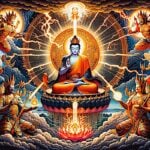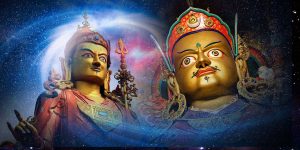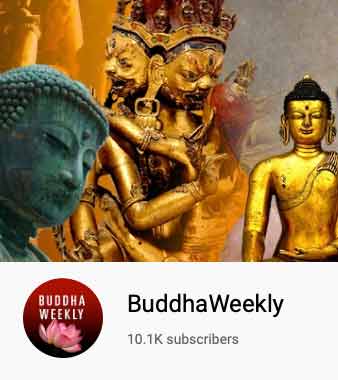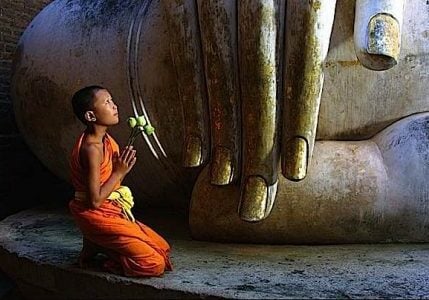Search Results: zasep tulku
Visualization Activates the Mind; Mindfulness Stills the Mind — Which is Right for Your Buddhist Practice?
The great Lama Yeshe said: "Our problem is that inside us there is a mind going, 'Impossible, impossible, impossible. I can't, I can't, I can't, I can't' ... Human beings have great potential; they can do anything. The power of the mind is limitless." To subdue this "I can't" mind, many Buddhists...
21 Taras Surya Gupta Thanka — stunning art by Angeli Lhadripa Shkonda: interview featuring 21 Tara closeups
Angeli Lhadripa Shkonda's artistic vision focuses her beautiful artistic skills on her beloved Tara Buddha. Taught by traditional teachers, Angeli creates thangkas that are luminous with Enlightened energy, alive with colour and detail and discrete gold details. We are pleased to showcase her beautiful 21 Taras artwork — in the tradition of...
The Profound Practice of Taking Refuge: the foundation of Buddhist liberation, faith, devotion, protection by Jason Espada
Committing ourselves to the teachings with faith and devotion is the cornerstone of everything else we would accomplish through the practice of this path— higher rebirth, or a safe direction for all our lives, accomplishing the individual liberation vows, and the bodhisattva vows and activities. We can strengthen our dedication, and everything...
The Dalai Lama and eight other teachers explain how to avoid taking Refuge in the wrong things and why Refuge can help us overcome obstacles
"We are extraordinarily adept at taking refuge, the problem is we take refuge in the wrong things." writes noted Buddhist teacher and psychologist Rob Preece, in his breakthrough book, Preparing for Tantra. [1] Rob Preece explains what he means by "wrong things": "We take refuge from our stress, our emotional problems, and our...
“Learning how to die” and “Why Meditating on Death May Bring Joy to Life”: What the Buddhist Teachers Say About End of Life, Dying, and Palliative Care
Thich Nhat Hanh: "The notion of death cannot be applied to reality." The great teacher Thich Nhat Hanh, who passed away at 00:00hrs on 22nd January, 2022, at the age of 95, often wrote about impermanence, with an optimistic take on death: "When you look a cloud... and then later the cloud...
Chod practice: offering yourself to all beings, the ultimate expression of bodhichitta
The vivid and visceral imagery of Chod Practice — where you visualize offering your own body to all sentient beings, chopped up into grisly bits, and presented in a human skull — can lead to extreme misunderstanding. Teachings such as Chod are advanced and profoundly effective practices that help us "cut" our ego,...
Padmasambhava: “the source of accomplishment is the Yidam”; Yidam is systemized practice, not just a “deity”
"The source of blessings is the lama, the source of accomplishment is the yidam, and the source of activities is the dakinis." — Guru Rinpoche Padmasambhava Yidam is a method — usually a defined system of practices — rather than just a "deity" — as clearly stated by the great Lotus Born...
Visualizing your heart bond Yidam. How to choose one, how to improve clarity and concentration: Advice from Teachers
What advice do you have for students who have difficulties visualizing their Yidam to help them improve clarity and stabilization? Can you speak about how to pick a personal Yidam for your practice? [Transcript below video] Note: In Vajrayana advanced meditation, the student activates the mind's enlightened qualities by visualizing him/herself to...
Deity Yoga: Science or Superstition? Vajrayana Deity Meditation Proves Invaluable in Preventing Cognitive Disorders. In What Other Ways is Vajrayana Buddhist Deity Practice More Science than Religion?
Deity Yoga in Tibetan Buddhism is very often misunderstood. In apparent contradiction to the implied meaning of "deity" — which is really a mistranslation of the Sanskrit "deva" — there might, in fact, be more science than superstition to the practices of deities. It's a ridiculous notion, I know, but one I...















